TERRACYCLE NEWS
ELIMINATING THE IDEA OF WASTE®
Posts with term Include Canada (English) X
Henkel, TerraCycle to recycle detergent pouches
How to Spring Clean Your Closet
There is something about spring that always seems to inspire cleaning. As temperatures warm up after a long, dark winter spent inside with little opportunity to ventilate with open doors and windows, you might find yourself digging through layers of coats, scarves, and sweaters in your closet. While looking for those warm-weather essentials, you have probably said to yourself, “It's time to clean out this closet.”
RELATED: 8 Ways to Give Your Bedroom Sex Appeal
This means it’s the perfect time for a good spring cleaning. We talked to some experts who know a thing or two about how to get a closet organized and keep it that way. It’s not as difficult a task as you might think.
Start With a Plan

First things first: Don’t be too hard on yourself if you have accumulated a lot to deal with since the last time you cleaned out the closet). Not everything has to be tackled at once. California Closets design consultant Nicole Caswell recommends tackling one section at a time so the whole project isn’t overwhelming.
“The easiest way to to start the decluttering process is to really see what you’ve got. Go into the project knowing your end goal,” says Caswell. “Do you want to minimize your wardrobe, display your clothing, or organize your pieces by season? You will more likely achieve a well-organized closet if you are focused on a specific end result.”
“Avoid stress with a realistic goal,” San Francisco-based professional organizer and "Thumbtack Pro" Molly Cole of Cole + Co tells us. “A lot of my clients tell me they feel like they make an even bigger mess when they try to organize their closets.” She advises that even if you only get rid of a couple of items, you’ll feel better about your project if you achieve what you initially set out to do. “Have a plan for the items you decided to part with [and] remember to give yourself time to make that run to [a donation center such as] Goodwill.”
Fellow Thumbtack Pro Michael Dimopoulos of Lazy Susans Cleaning Service in New York City recommends taking the following into consideration before starting: “If I’m just seasonally rotating my wardrobe, I need to be clever about what stays and what goes, in the event that I need to find a particular item.”
Know Your Personal Limits

“Our closets are extremely personal, and there is not a ‘one method fits all’ approach to reorganizing your belongings,” points out Caswell. “Some might want to toss out their items and save the bare minimum, while others may want to keep everything and maximize their storage space.”
“Any method that gets you past procrastination is the best one for you,” agrees Lynnette Khalfani-Cox, clothing resale app Mercari’s finance expert and founder of Ask The Money Coach. “[According to a recent Mercari study] Americans currently have an estimated $93 billion in unused stuffcluttering our homes … just take the first step!”
The KonMari Method is the organizing method du jour, but watch for variations on the theme. “It’s important to remember that nostalgia is not your friend,” says Cole. “Many people want to hold on to items, not because they have any practical use, but simply because it brings up memories” She encourages her clients to think about the actual memory an item is connected to. Does it bring up a happy memory or a sad one? “If it’s the latter, it’s probably time to let it go,” she says.
“KonMari is very popular, but I found that it wasn’t for me,” The Container Store’s closet buyer Jimmy Seifert says. “It’s extreme … We like to hold on to things that have meaning … It’s easy to get rid of something that you’ve been holding on for years if it doesn’t mean much to you.” He swears by the Japanese minimalism book titled “Goodbye Things,” wherein author Fumio Sasaki changes his life by getting rid of everything he doesn’t absolutely need. “That actually pushed me to go beyond my comfort zone.”
RELATED: How Often You Should Be Replacing Your Sheets
Seifert recommends hiring a service, suggesting that some can even help with a move; purging, packing, and organizing as you leave one dwelling for another.
“It’s very important to give your space a once-over and remove items — especially big ones — that you want to get rid of before you start,” Cole says as a big believer in purging before organizing. “This clears up space and makes organizing much easier in the long run. I like to designate a space for those items outside the ‘organizing zone’ so you’re not stepping over anything or creating more clutter.”
Jordan Barnes, senior director of brand and communications at Mercari, likes to follow this rule of thumb: If you haven’t worn it or used it in a year, get rid of it. “Take a good look at all the stuff in your closet you’re no longer using,” she says. “Think about why you bought it. Maybe you moved to a new city with different weather. Maybe you upgraded to a newer phone. Maybe you just never got around to actually wearing those athletic shoes. You bought all that stuff for good reason [and] so will someone else.”
Maximize the Most Minimal Space

Even professional organizer Dimopoulos admits to feeling the limitations of space. “Living in New York City, unfortunately most of us don’t have much of a choice but to keep some things in off-site storage. You could vacuum-seal heavier items such as coats jackets, and bags, and stack them on top of one and other to maximize the space … or the lack of it.”
Start by paying attention to how you fold. Cole recommends the KonMari folding method (check out YouTube for how-tos) for storing items vertically in drawers, maximizing space and accessibility. Sort clothes in the closet by type, then color. “Organizing is not just about clearing clutter; it’s also about making things aesthetically pleasing,” she points out. “I like to use this notion when organizing a closet, primarily because [it] tends to involve a lot of daily decision-making … which can cause stress and anxiety. If you wake up to a nicely organized closet, you’ll not only feel less stressed as you get dressed for work, but you’ll also feel a great sense of accomplishment when you get that daily reminder of the hard work you put in to organizing that space.”
 The Container Store
The Container Store“When I am done with everything, I then have the space to coordinate and organize T-shirts, hanging or folded together, long-sleeved T-shirts, sweaters, shirts, jeans, trousers, etc.,” Dimopoulos agrees. “Everything has room to breathe. The ability to see everything is important. I now feel lighter and cleansed and have a sense of being organized.”
Caswell likes utilizing boxes, jewelry drawers, slide-out pant racks, and cabinet doors to store, display, and organize clothing. “When everything has its place, clutter is eliminated,” she points out. “When hanging clothing, make sure to purchase higher quality hangers that are preferably all the same. By keeping hangers, boxes, and containers consistent, your closet looks instantly cleaner.”
Of course, as a buyer for The Container Store, Seifert isn’t short on storage ideas. “Basic shoe storage is probably the most common issue. We also have hangers for just about anything: wooden are best if you have the space, but we also have space-saving ones. Bins and storage boxes are next: I use bins for things that I wear often, keeping them lower in my closet so I can see them. Boxes go up high for seasonal stuff. We also recommend drawer dividers to keep like items together. We have plastic versions, as well as cedar to prevent pests [such as moths].”
RELATED: How to Make Your Apartment Look Bigger
Seifert also shared his thoughts on plastic, both for its environmental impact, as well as whether it’s good for clothing storage. “It depends on what you’re storing,” he says. “We use the phrase ‘fur, feathers, and leathers.’ All of those things need to breathe. If they don’t, they can deteriorate or get moldy, so we recommend cotton storage for them. I wouldn’t put them in a box: Bins are best, or hangers. Cottons and synthetic materials are fine in plastic, though — I use clear plastic boxes for all my sweaters.
“As an alternative to plastic, we carry a brand of post-consumer fiberboard boxes from Sweden called Bigso,” he continues. “If you’re going to buy plastic, buy high-quality products that will last a long time and that don’t have to be replaced often because they crack and break easily. When you are done with them, they can be recycled.”
Donate, Sell, and Recycle the Rest

Still, now that your closet has been organized and styled, donate what you can’t sell to local charities. “It’s a good idea to review your items at least once a year,” says Caswell, “and if you don’t wear it, find it another home.”
Dimopoulos is a big believer in giving away clothes such as great sweaters, jackets, bags, and coats. “Luckily, I’ve always had someone in my life whose taste in clothes I admired … and who had the best brands that I couldn’t afford,” he says. “I love hand-me-downs. In fact, [over half] of my leather jackets, luxury brand bags, wallets, and coats are from upscale brands that I’d never buy at full retail.” Don’t be afraid to give things to friends and family that might not be as concerned that last season’s styles aren’t exactly “au courant.”
He even suggests doing what he does and always buying second-hand since, by his thinking, it means he saves more. “So yes, I ‘pay it forward’ by donating my excess wardrobe items.”
A quick survey of some of the larger “thrift” charities’ websites suggests that you can donate just about anything, from clothing, shoes, and boots to hats, gloves, and scarves, even some housewares and collectibles. Don’t donate things like personal care items and fragrance. The “Golden Rule” of thrifting applies here: Don’t donate to others that which you would not buy yourself (even if you’re not a second-hand shopper).
Toss or better yet, recycle pilled knits, clothing with holes, used swimsuits, underwear and socks … and anything that smells too bad to ever freshen up or that is badly stained. There are resources for clothing recycling such as Planet Aid which focuses on specific populous areas, TerraCycle which allows for bulk shipping of old textiles, and Earth911 which has an easy search feature that makes it quick and easy to find a drop-off location near you.
If you feel like taking the time, this is also the point at which your discipline may turn profitable. Apps and websites such as Let Go, Mercari, Grailed, Poshmark, The Real Real, even Amazon or the granddaddy of them all, eBay, may allow you to turn certain items back into cash. If you’re a real brand or label fan who has only worn your expensive things a few times or less, this has more potential than clothes or accessories that are in your regular rotation.
Khalfani-Cox suggests doing a quick search to see how much items similar to yours are selling for. That will help you decide whether it’s worth the effort to sell them or just make a donation. “For things you’d like to donate, bear in mind that, over the past few months, organizations like Goodwill say they’ve been overwhelmed due to the popularity of the KonMari tidying method,” she says.
A New Hope

Once those donations are made, Seifert recommends paring down shopping habits now that you’ve got room for a fresh start. “I find myself buying things that aren’t as trendy, focusing on more classic items that I can have for years if I take care of them,” he says. “I may have less, but what I do have is higher quality. I buy a lot more solid colors so I end up purchasing less all around. That’s a good next step.”
Spring is always a great season to whip that closet into shape and start the green season fresh. Remember, this is not reality TV: Do things at your own pace and set realistic goals. Ask an expert for advice, which could be an organized friend, a hired hand, or even just found within the pages of a book. Be sure to have a clear separation between the “toss pile,” and what you’re keeping.
If you live in a small space, and can afford it, don’t overlook off-site storage if that’s the best solution for you. The “spark joy” conversation may be one best saved for your therapist … even Martha Stewart admits to having a bit of a hoarding mentality. Once you’re done, remember to sell, give away, or donate your cast-offs to your favorite charity.
Henkel, TerraCycle to launch free recycling program in Canada
Rethinking packaging production, distribution, and afterlife
12 Companies That Are Making It Easier to Produce Less Trash
Loop
Inside Canary, the New Refillery and Zero Waste Market in Kensington
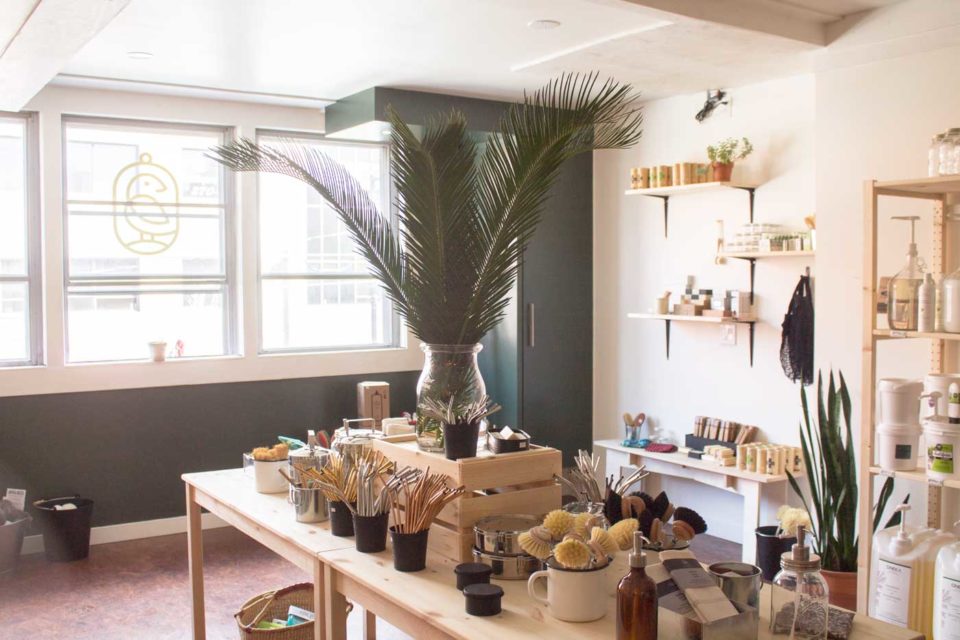 From the launch of the Calgary Composting Facility in 2017 to the more recent push to get rid of plastic straws in local restaurants, more and more Calgarians have environmental issues on the brain. Canary, a new refillery and zero waste market in Kensington, is the latest addition to that conversation in Calgary.
Launched by longtime friends Tara Meyer and Lisa Watts, Canary specializes in sustainable, plastic-free lifestyle products. Most of the store’s products are package-free and the rest come in recyclable/compostable packaging. There are blocks of Savon de Marseille soaps, shampoo and conditioner bars, Ziploc bag alternatives like reusable Stasher bags, dryer balls, sustainable brushes, stainless steel straws, bamboo toothbrushes and more.
Canary also has a refillery section where containers can be filled (and later refilled) with things like shampoo, conditioner, shower gel, bubble bath, lotion, deodorant, hairspray and toothpaste.
While many of Canary’s customers are already familiar with the idea of zero waste and sustainable products, others are discovering just how many sustainable options are out there for the first time. The goal, Meyer says, was to create a space where people could easily discover and access environmentally friendly products and start thinking about how they can make a difference in small ways.
“We’re simply hoping that people might start thinking about [things like] what’s one thing I can switch out that’s an easy swap to make? Like maybe this month, when my razors run out, I’m going to think about getting a metal razor and see how that goes. And if I like that, great. That’s one thing you’ve done and one less thing that goes to landfill,” Meyer says.
“When lots of people do little things like that, it really does add up.”
1223 Kensington Rd., canarygoods.ca
From the launch of the Calgary Composting Facility in 2017 to the more recent push to get rid of plastic straws in local restaurants, more and more Calgarians have environmental issues on the brain. Canary, a new refillery and zero waste market in Kensington, is the latest addition to that conversation in Calgary.
Launched by longtime friends Tara Meyer and Lisa Watts, Canary specializes in sustainable, plastic-free lifestyle products. Most of the store’s products are package-free and the rest come in recyclable/compostable packaging. There are blocks of Savon de Marseille soaps, shampoo and conditioner bars, Ziploc bag alternatives like reusable Stasher bags, dryer balls, sustainable brushes, stainless steel straws, bamboo toothbrushes and more.
Canary also has a refillery section where containers can be filled (and later refilled) with things like shampoo, conditioner, shower gel, bubble bath, lotion, deodorant, hairspray and toothpaste.
While many of Canary’s customers are already familiar with the idea of zero waste and sustainable products, others are discovering just how many sustainable options are out there for the first time. The goal, Meyer says, was to create a space where people could easily discover and access environmentally friendly products and start thinking about how they can make a difference in small ways.
“We’re simply hoping that people might start thinking about [things like] what’s one thing I can switch out that’s an easy swap to make? Like maybe this month, when my razors run out, I’m going to think about getting a metal razor and see how that goes. And if I like that, great. That’s one thing you’ve done and one less thing that goes to landfill,” Meyer says.
“When lots of people do little things like that, it really does add up.”
1223 Kensington Rd., canarygoods.ca
Take a look inside Canary
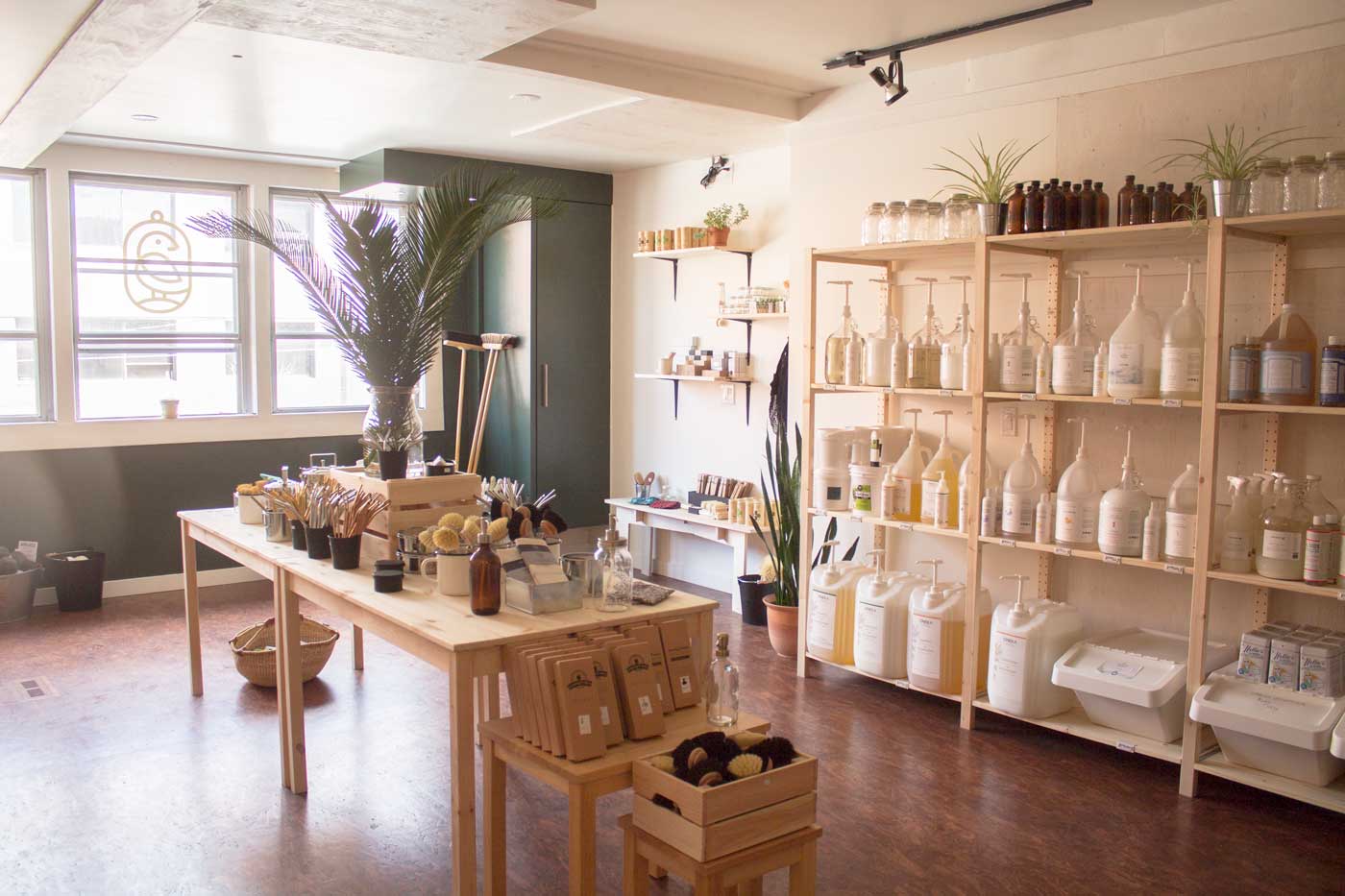
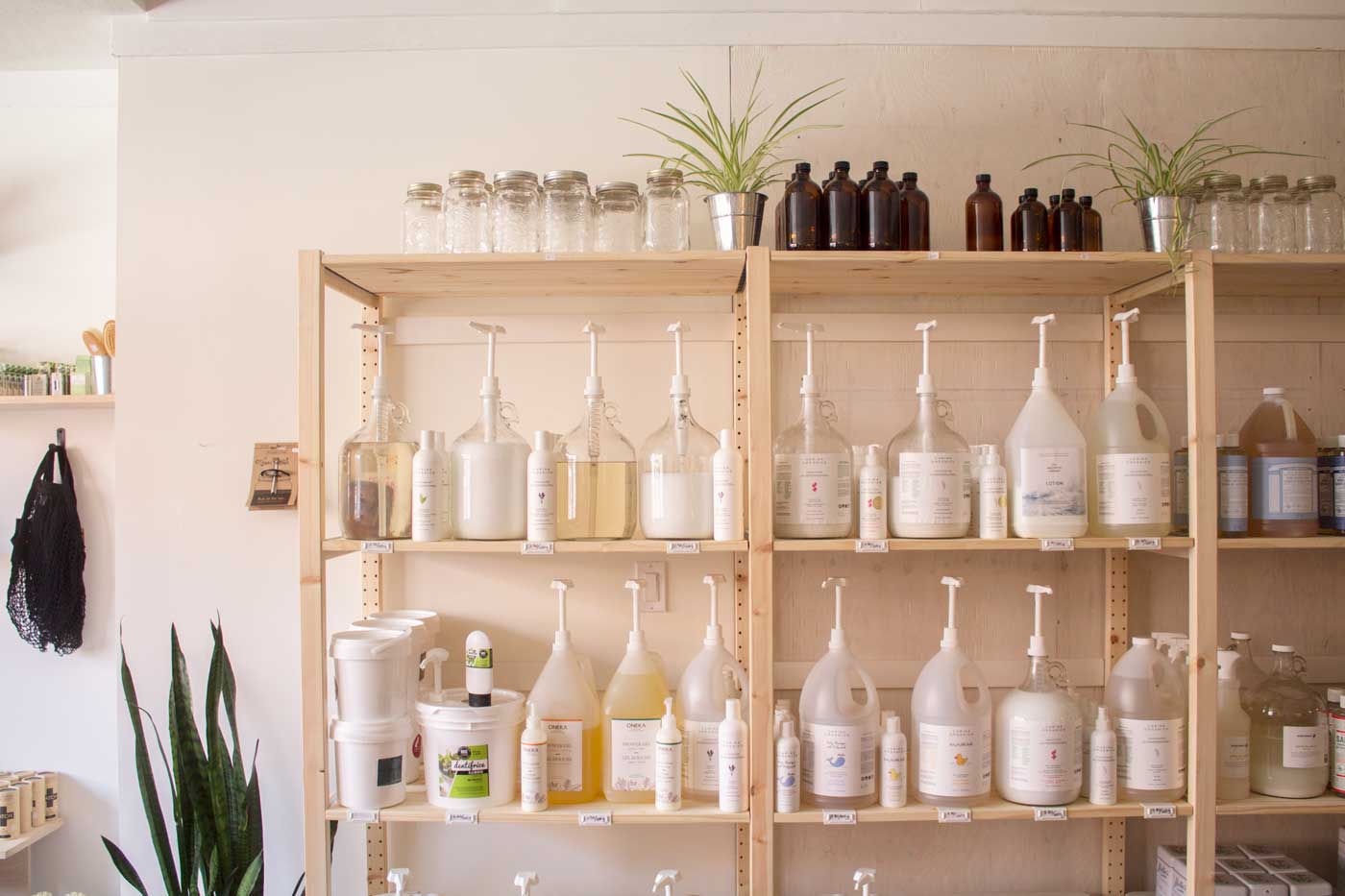 Canary carries a selection of refillable products, including cleaning vinegar, dish soap, lotion and all-purpose cleaner from The Unscented Company, shampoo, conditioner, body wash, bubble bath and hairspray from Carina Organics, mint toothpaste from Rose Citron, Routine deodorant and more. Shoppers can bring in a container to fill, grab a free used container from Canary (such as an old shampoo bottle) or buy a Boston round or mason jar to fill. All the refillable products are priced by weight.
Canary carries a selection of refillable products, including cleaning vinegar, dish soap, lotion and all-purpose cleaner from The Unscented Company, shampoo, conditioner, body wash, bubble bath and hairspray from Carina Organics, mint toothpaste from Rose Citron, Routine deodorant and more. Shoppers can bring in a container to fill, grab a free used container from Canary (such as an old shampoo bottle) or buy a Boston round or mason jar to fill. All the refillable products are priced by weight.
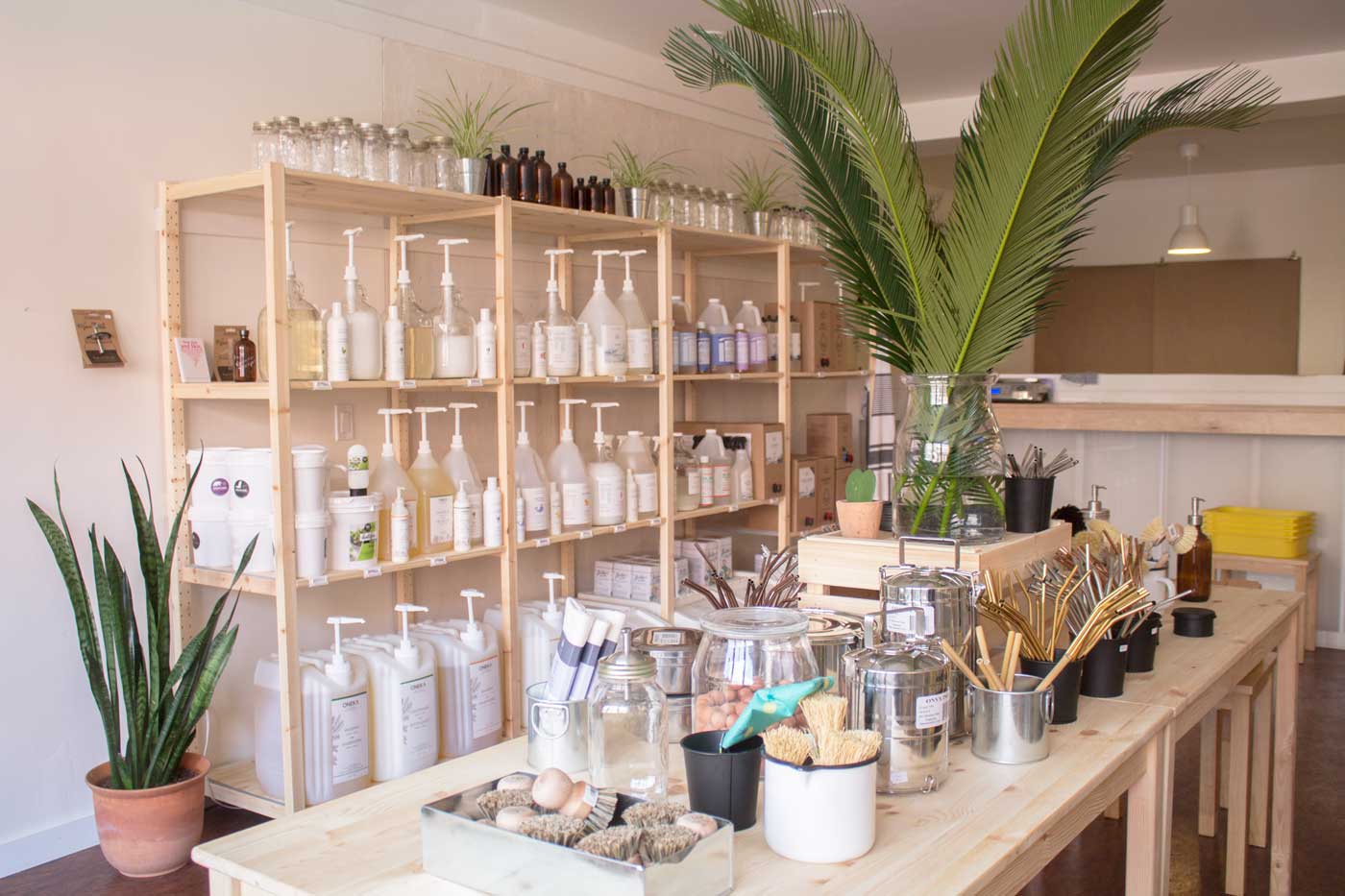
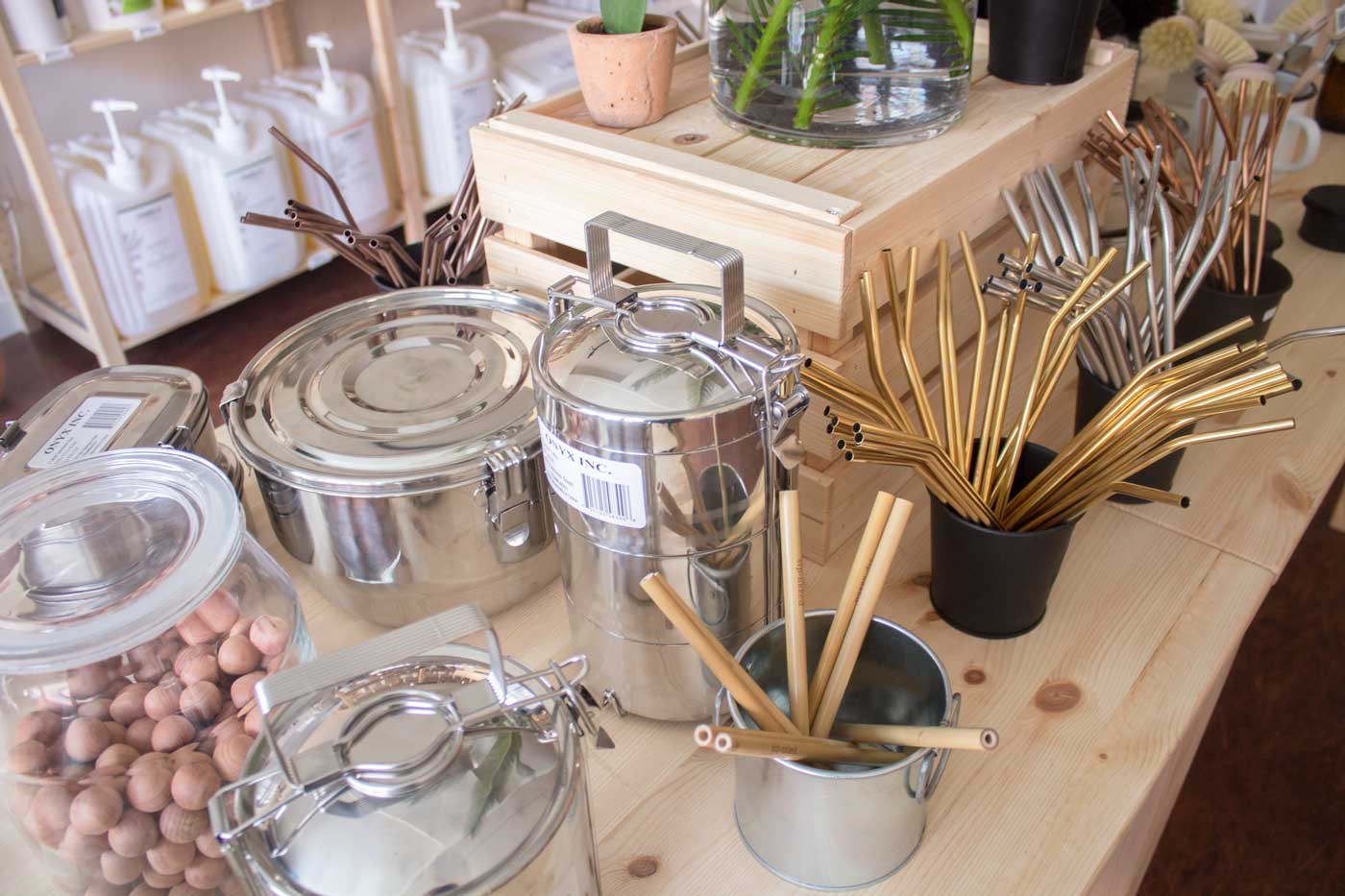 German company Burstenhaus Redecker makes these compostable feather dusters, brooms, toilet brushes and dish brushes with natural bristles.
German company Burstenhaus Redecker makes these compostable feather dusters, brooms, toilet brushes and dish brushes with natural bristles.
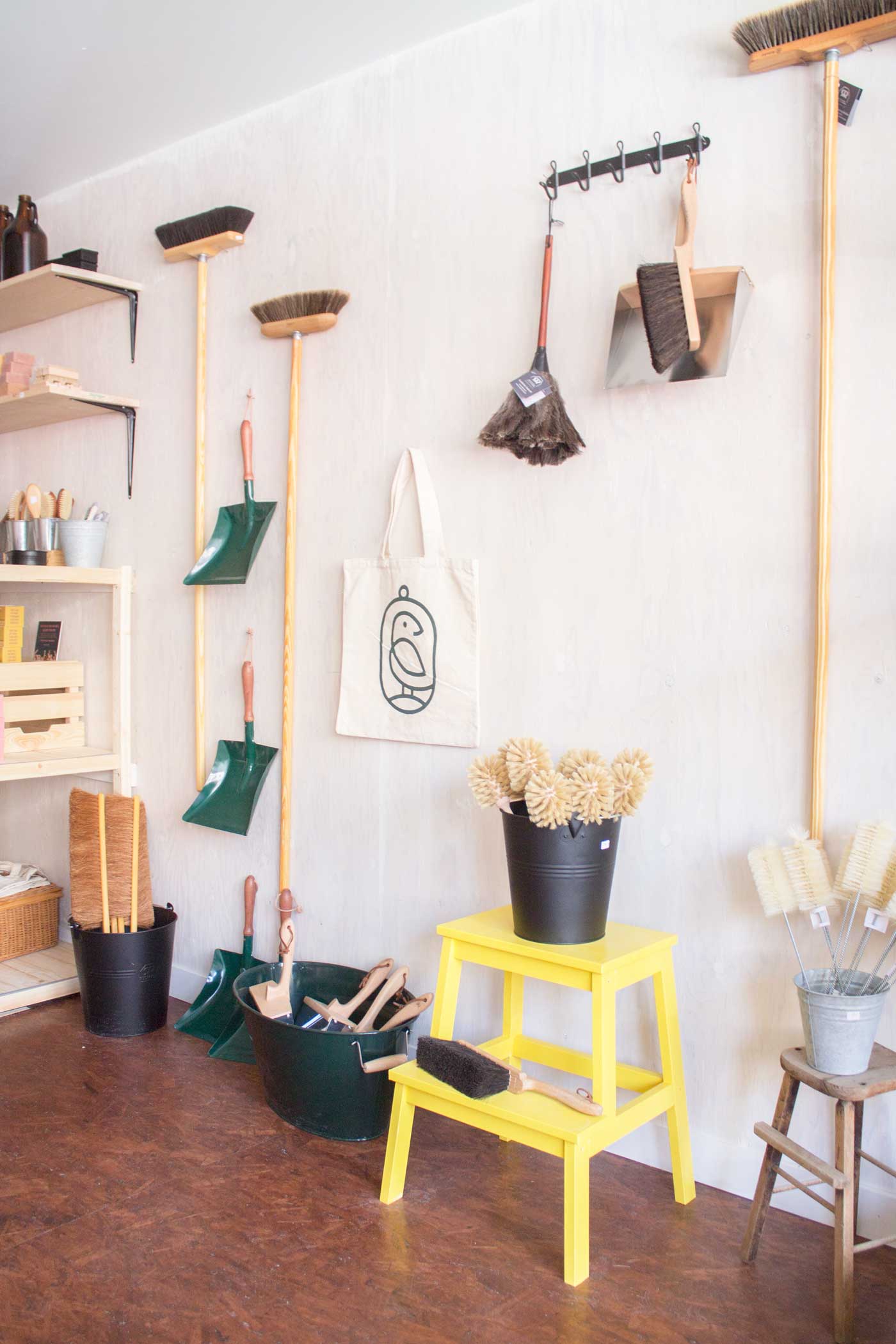 Looking for an alternative to plastic wrap? Try this beeswax food wrap from Abeego, which Meyer says have “the perfect amount of stick, but [aren’t] too sticky.”
Looking for an alternative to plastic wrap? Try this beeswax food wrap from Abeego, which Meyer says have “the perfect amount of stick, but [aren’t] too sticky.”
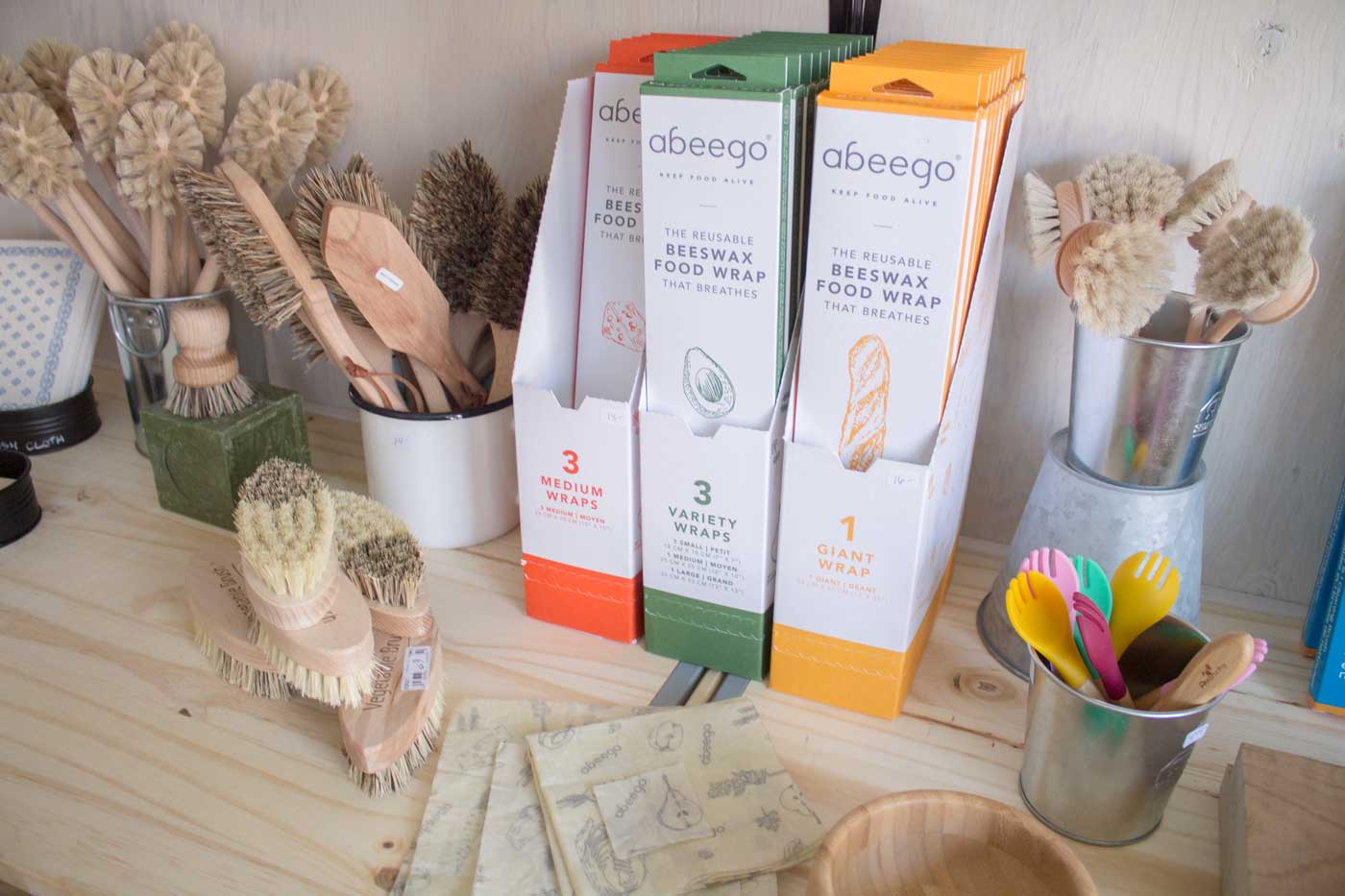 This natural toothpaste from American company Davids comes in a metal tube that can be recycled when it’s empty. Canary also has Brushed Naked bamboo toothbrushes that can ultimately be recycled and composted. If you’re looking to transition from plastic toothbrushes to more sustainable ones, Canary has a TerraCycle recycling box in-store where customers can dispose of their old ones.
This natural toothpaste from American company Davids comes in a metal tube that can be recycled when it’s empty. Canary also has Brushed Naked bamboo toothbrushes that can ultimately be recycled and composted. If you’re looking to transition from plastic toothbrushes to more sustainable ones, Canary has a TerraCycle recycling box in-store where customers can dispose of their old ones.
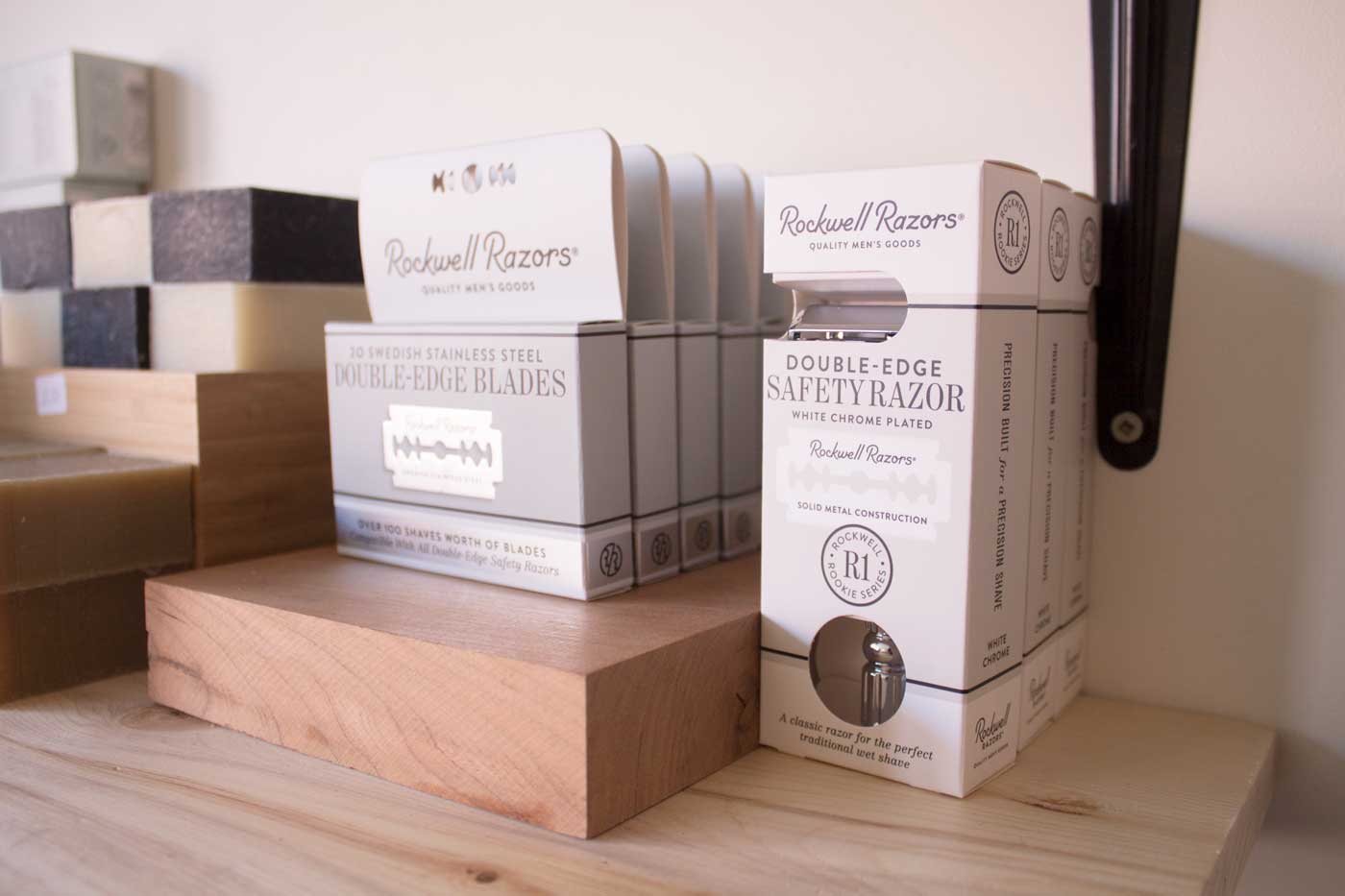 Canary carries safety razors with replaceable stainless steel blades. When customers are done with the used blades, they can bring them back to Canary to be recycled with a local metal recycler.
Canary carries safety razors with replaceable stainless steel blades. When customers are done with the used blades, they can bring them back to Canary to be recycled with a local metal recycler.
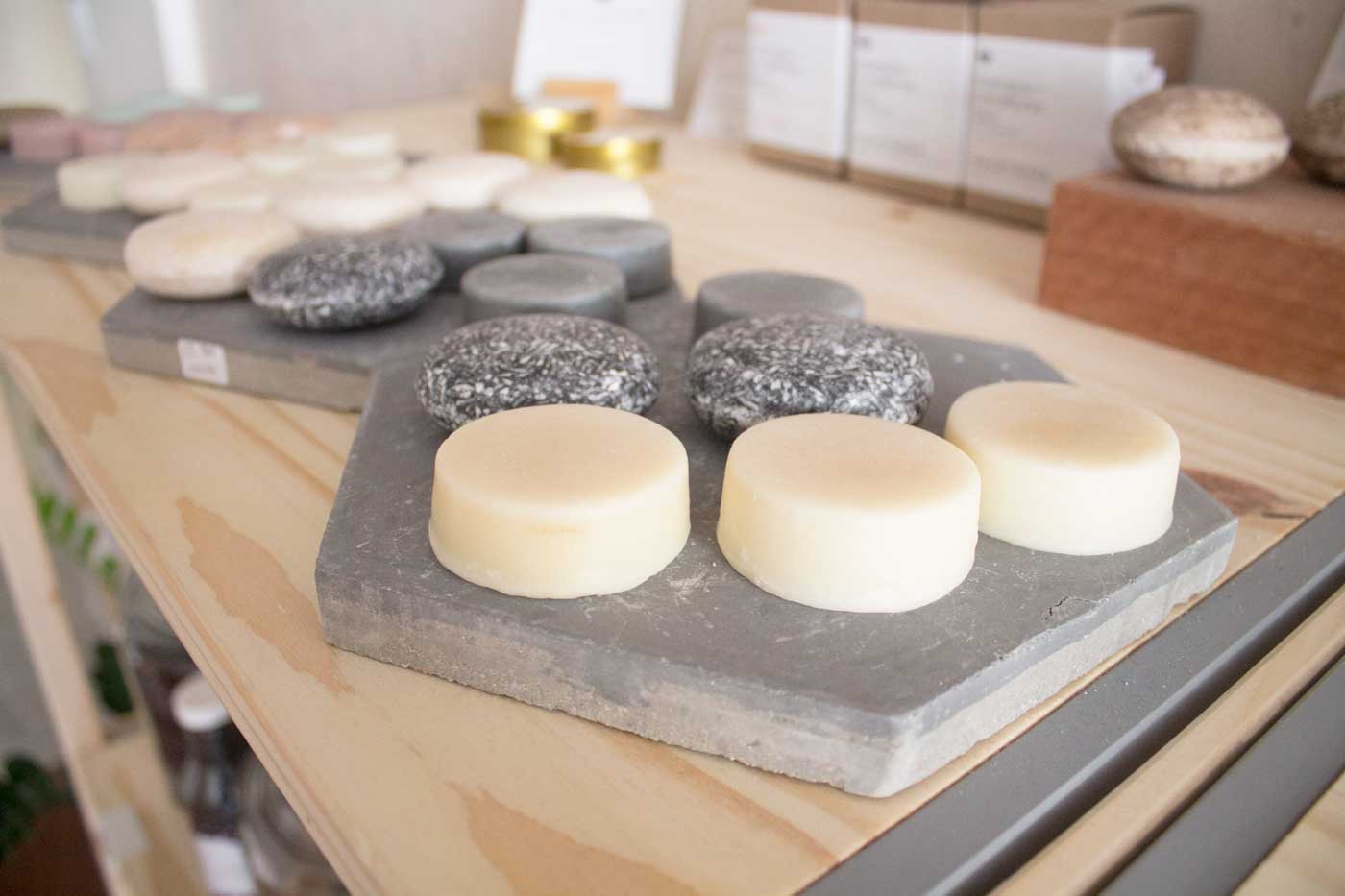
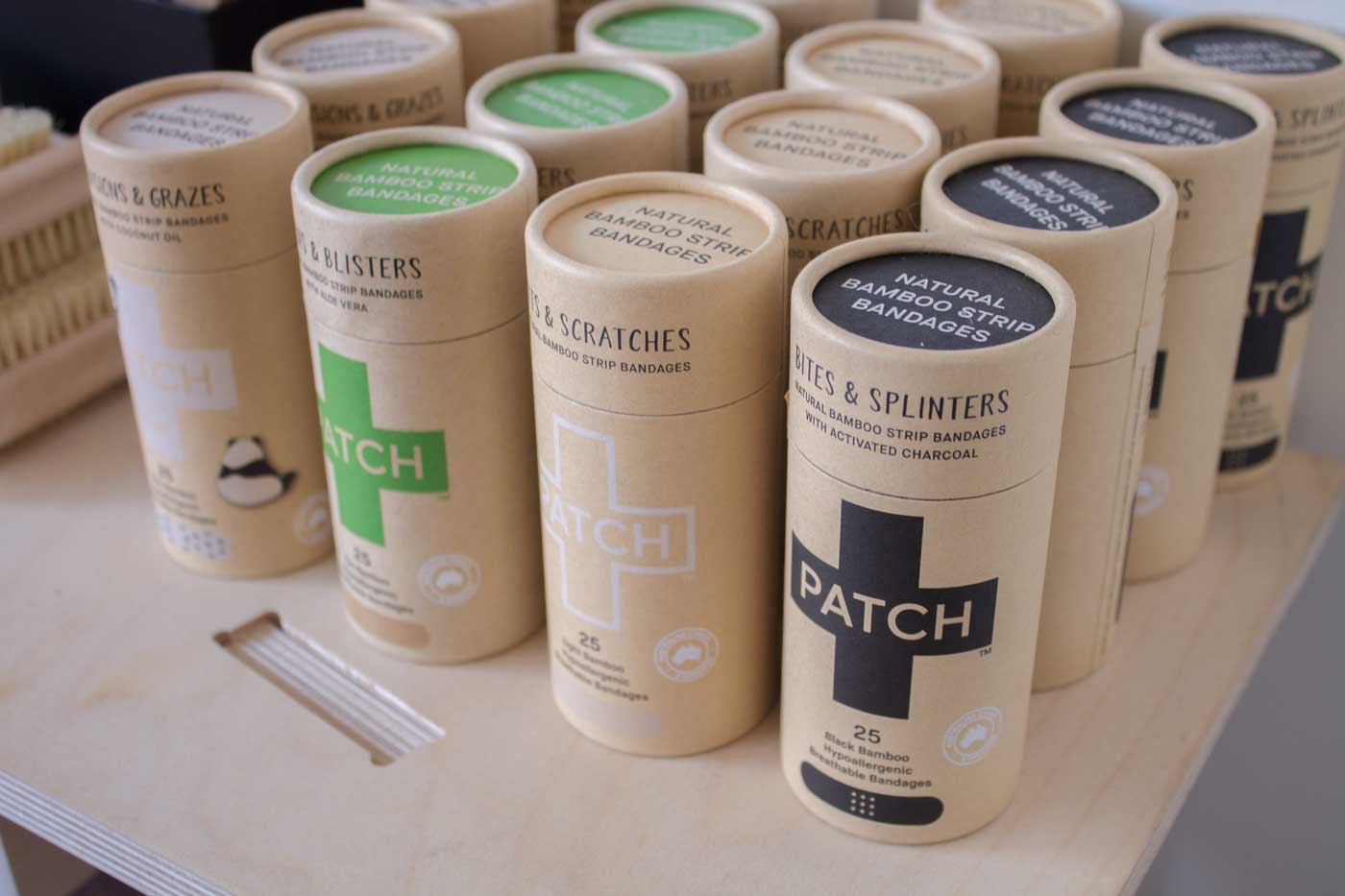 There’s even a sustainable option for bandages — Australian company Patch makes plastic-free (and beautifully designed) bamboo bandages that can be composted.
If you don’t want to to go with liquid shampoo and conditioner, Canary has zero waste shampoo and conditioner bars from Calgary company Unwrapped Life
There’s even a sustainable option for bandages — Australian company Patch makes plastic-free (and beautifully designed) bamboo bandages that can be composted.
If you don’t want to to go with liquid shampoo and conditioner, Canary has zero waste shampoo and conditioner bars from Calgary company Unwrapped Life
